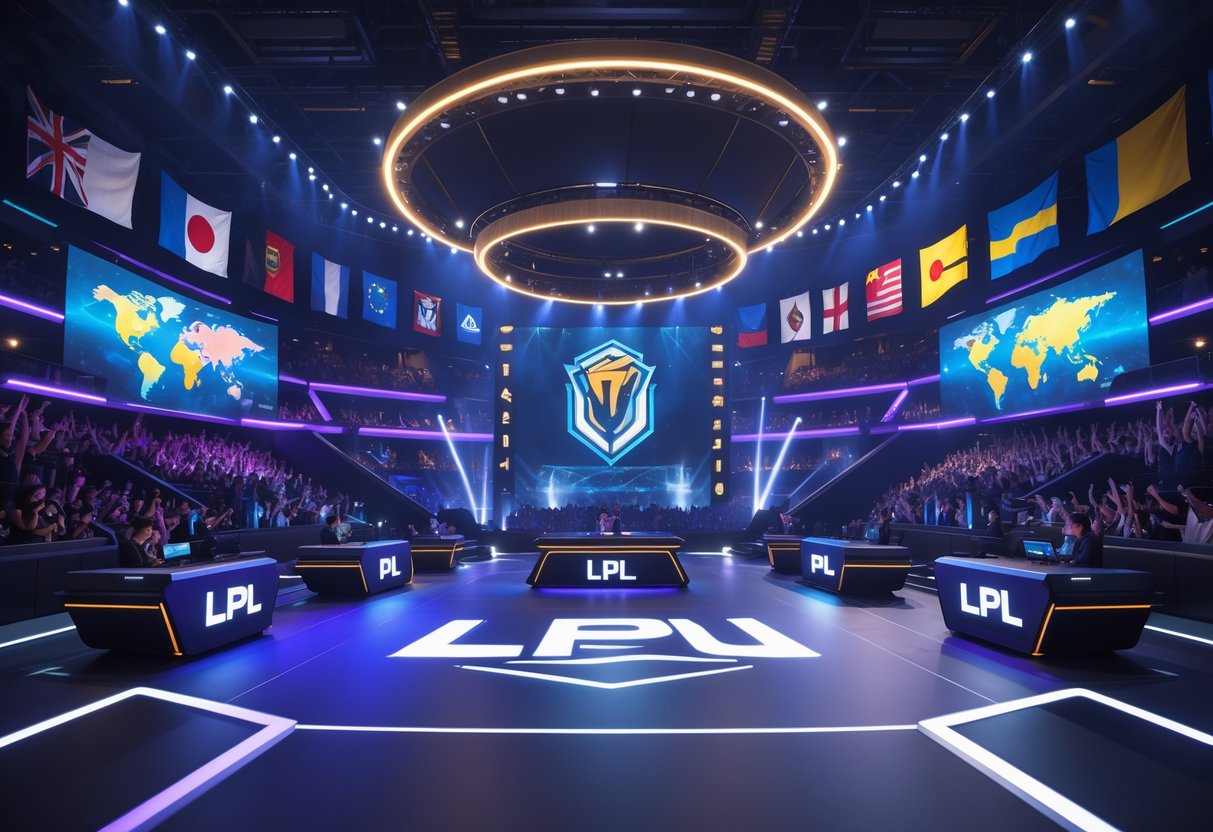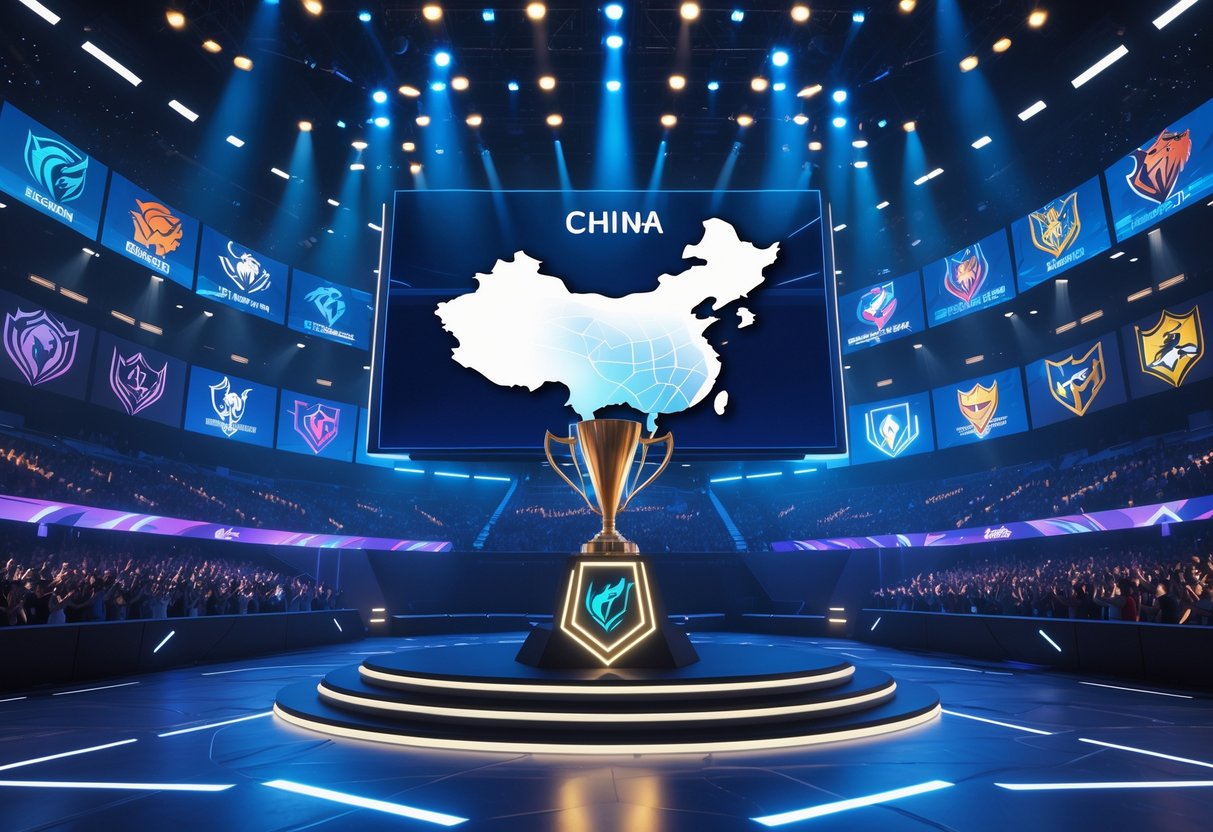LPL International Slots: Explained, Allocations, and Global Impact
Updated On: October 23, 2025 by Aaron Connolly
What Are LPL International Slots?

LPL international slots basically mean the spots China gets at big League of Legends tournaments like Worlds and MSI. They decide how many Chinese teams get to show up on the world stage each year.
Definition and Importance
The LPL (League of Legends Pro League) stands as China’s top professional League of Legends competition. International slots are the guaranteed places LPL teams get at global tournaments.
Right now, the LPL receives three base slots for Worlds. Teams can snag a fourth slot if they perform well internationally, especially at MSI.
These slots matter a lot for Chinese esports. The more slots, the bigger the shot at prize money, international exposure, and—let’s be honest—regional bragging rights. The LPL keeps showing up as one of the strongest leagues, right up there with Korea’s LCK.
For fans, more slots mean more games to watch and a wider range of Chinese team strategies on display.
Quick win: If you follow LPL teams through spring and summer, you’ll get a sense of which squads might make it to the big stage.
Criteria for Slot Allocation
Riot Games hands out slots based on how regions perform internationally. LPL teams’ results at Worlds and MSI directly affect how many slots they get.
Base allocation rules:
- Three guaranteed Worlds slots each year
- Two MSI slots per year
- Extra slots awarded for tournament success
A fourth Worlds slot comes from specific achievements. If an LPL team wins MSI, the region gets an extra slot. Strong semifinal runs can also help bump up the number.
Regional consistency matters too. If LPL squads keep making deep runs internationally, Riot often rewards them with more slots.
Heads up: Slot numbers aren’t set in stone. If the LPL underperforms, they could lose a slot.
Slot Types and Tournament Entry
LPL international slots break down into a few categories depending on the tournament and the region’s strength.
Worlds slots:
- Direct slots: Top teams qualify straight through LPL playoffs
- Play-in slots: Lower seeds start in preliminary rounds
- Bonus slots: That fourth slot, if earned via MSI
For MSI, the LPL usually sends the spring split winner plus one more team. Both compete in the international group stage.
The new seasonal format now has regional championships. Each split ends with teams fighting for the chance to represent China.
Teams enter tournaments at different stages. Top seeds skip the play-ins, while lower seeds have to battle through extra rounds against up-and-coming regions.
Next step: Check out current LPL standings to see which teams are in the running for international slots.
Qualification Process for LPL International Slots

The LPL uses a three-tier system to decide which teams get international slots. Teams qualify by winning LPL Split 3, racking up championship points throughout the year, or taking the regional finals.
LPL Split Performance
The Split 3 Champion grabs the first seed for international events. This split runs July through September, with 14 teams battling it out in a round-robin and then playoffs.
After Split 2, Royal Never Give Up and Oh My God left the league. Now, teams like Bilibili Gaming, JD Gaming, and EDward Gaming fight for that championship spot.
Championship points pick the second seed. Teams earn these points based on where they finish in each split, and later splits matter more.
Teams like Top Esports and Weibo Gaming usually stack up a lot of points. The team with the most points (not counting the Split 3 winner) takes the second slot.
Playoffs and Rankings
Regional Finals decide the third seed with a bracket tournament. Teams that didn’t qualify through Split 3 or points get another shot here.
Six teams play in the regional finals, double-elimination style. Seeds 3-6 from the points standings start in the lower bracket; seeds 1-2 get a bit of an advantage in the upper bracket.
| Qualification Method | Seed | Format |
|---|---|---|
| Split 3 Champion | 1st | Direct qualification |
| Championship Points | 2nd | Season-long accumulation |
| Regional Finals Winner | 3rd | Tournament bracket |
| Regional Finals Runner-up | 4th* | Tournament bracket |
*Fourth seed only appears if LPL earns an extra slot via MSI.
Tiebreaker Scenarios
When teams tie on championship points, head-to-head records from the regular season come first. If that’s still tied, the most recent split result decides it.
Summer split results count double compared to spring. So a big finish in Split 3 can make up for rougher starts earlier in the year.
Regional finals seeding follows the points rankings. If teams tie on points, their Split 3 regular season record breaks the tie.
Sometimes, teams like FunPlus Phoenix miss out even after strong early splits. The system really rewards teams that stay consistent across all three splits.
LPL Representation at Worlds

The LPL usually sends four teams to the League of Legends World Championship each year. This depends on how well the region performs at events like MSI; strong showings can earn them that extra spot.
Number of Slots for Worlds
The LPL gets four Worlds slots when they do well at MSI. In 2025, Bilibili Gaming locked in the fourth slot by making the MSI finals and ensuring China finished top two.
The slot system is flexible. Since 2021, Worlds has had two “flexible” slots: one for the MSI winner’s region, one for the most consistent international performer.
Current LPL allocation:
- 3 guaranteed slots (standard for major regions)
- 1 extra slot (earned at MSI)
- Total: 4 teams to Worlds
The fourth team starts in the Play-In stage and has to fight for a main event spot. The other three get in directly.
Seeding and Group Distribution
LPL’s top three teams go straight to the main event. The fourth team works through Play-Ins, facing a gauntlet of best-of-fives.
How LPL teams qualify:
- 1st seed: Spring champion or highest points
- 2nd seed: Summer champion (if not already qualified)
- 3rd seed: Regional finals winner
- 4th seed: Play-In qualifier
The LPL’s strong international rep usually gets them good seeding. Teams rarely land in the same group early on.
If you look back, the LPL has kept up consistent Worlds appearances. They’ve held onto that fourth slot for several years thanks to MSI wins from squads like RNG and Bilibili Gaming.
Historical LPL Performances
The LPL has built a reputation as one of the world’s strongest regions at Worlds. In the last three years, they’ve put seven teams in the top eight, which is pretty wild.
They’ve also taken home multiple championships since 2018. LPL teams adapt fast to international metas and always seem ready to take on Korea.
Standout stats:
- 7 teams in top 8 over three Worlds
- Several championship wins since 2018
- Good record against EU and NA
Every year, the LPL sends different teams, keeping things unpredictable. This rotation keeps other regions guessing and proves how deep the talent pool is.
LPL squads usually shine in best-of-five series. Their aggressive style and mechanical skill often wear down opponents in long knockout matches.
Impact of Mid-Season Invitational on LPL Slots

MSI results directly decide how many LPL teams get to go to Worlds. The tournament shapes both the current slot allocation and the region’s longer-term presence at Worlds.
MSI Results and Rewards
The Mid-Season Invitational isn’t just a mid-year event—it actually shapes who gets to show up at Worlds.
Most regions get three guaranteed Worlds slots. But MSI performance can unlock more chances for top regions.
MSI brings together the best teams from each major region. LPL sends two teams to battle it out with LCK, LEC, and others.
MSI rewards:
- Two flexible Worlds slots up for grabs
- Top MSI regions get a fourth Worlds slot
- Regional strength judged by tournament finish
At MSI 2025, both LPL and LCK landed in the top four, so both regions locked in extra Worlds spots.
The system rewards regions that keep performing. If you’re consistent at MSI, you keep your Worlds presence strong.
MSI Winner’s Slot
Winning MSI is the surest way to lock down an extra Worlds slot. The champion’s region automatically gets one of the two flexible slots.
This system has helped the LPL more than once. Every time an LPL team wins MSI, China nabs a fourth Worlds seed.
That winner’s slot really matters for the region. More Worlds spots mean more teams get international experience and a bigger stage.
MSI winner perks:
- Guaranteed fourth Worlds slot
- More prize money spread across teams
- Boosted regional reputation
Royal Never Give Up’s MSI win showed how this works. Their victory earned the LPL another Worlds slot the next time around.
The winner’s reward makes MSI fiercely competitive. Teams know that winning brings benefits for the whole region, not just themselves.
Influence on Worlds Qualification
MSI results can totally shake up how LPL teams qualify for Worlds. With four spots instead of three, more squads get a shot at the big stage.
That extra slot usually starts in Play-Ins, but it’s huge for developing teams.
How it changes things:
- Fourth-place teams get a Worlds chance
- Domestic competition eases up a bit
- Younger players get international exposure
Teams now plan their seasons around the possibility of four slots. Orgs invest more, knowing there’s more room to qualify.
It’s kind of a feedback loop—MSI success leads to more Worlds experience, which helps LPL teams do even better at the next MSI.
As more teams get high-level experience, the LPL as a whole just gets stronger.
Changes to Slot Allocations Over the Years

The LPL has changed its slot allocation system a lot since it started. Things have shifted from strict structures to more flexible setups, with new promotion and relegation rules, regular policy tweaks, and some big differences from the early days.
Flexible Slots Introduction
The LPL added flexible slot systems to keep up with China’s growing League of Legends scene. Instead of sticking to the old 12-team format, the league expanded to let in more orgs while still keeping things competitive.
Franchising Impact Moving to franchising got rid of the old promotion and relegation system. This brought stability for teams investing in LPL slots, since they didn’t have to worry about getting kicked out just for one bad season.
Financial Requirements New slot allocations now come with big financial commitments. Orgs have to show they’re in it for the long haul and can invest in the league. This keeps the LPL professional and sustainable.
Riot Games can now adjust team numbers based on how the market shifts. Thanks to this flexible approach, the LPL has grown from its original format to become the biggest major League of Legends league in the world.
Recent Policy Updates
The past few years have really shaken up LPL slot management. The league keeps tweaking its approach to balance competition while still making room for growth.
Revenue Sharing Models
Teams now get more predictable income streams from league partnerships, thanks to new revenue sharing agreements tied to slot allocations. These changes give smaller organisations a better shot at keeping up with the established giants.
Performance Standards
The LPL now requires slot holders to meet minimum performance standards. Teams need solid operational setups, including player development programs.
These standards push every organisation to help raise the league’s overall quality.
International Representation
Policy updates now factor in how teams perform internationally when managing slots. If a team does well at Worlds or MSI, that can influence future slot decisions.
This keeps the LPL’s global reputation strong.
The league also made changes to rules about ownership transfers and slot trading.
Comparison With Earlier Seasons
Early LPL seasons looked nothing like today’s setup. Back then, slot allocation was all about promotion and relegation through the LSPL.
Original Structure vs Modern Format
In the early days, only 8-12 teams played each split, and relegation loomed if you performed poorly. Teams could lose their spots just by having a bad split.
Now, the system prioritises stability and long-term investment over pure results.
Investment Requirements
It used to take just a modest investment to buy into the league. Teams could join with limited backing.
Today, slots require multi-million dollar commitments and a serious operational presence.
Regional Representation
The old system let more regions in through promotion tournaments. Even smaller cities could field competitive teams.
Now, bigger cities with stronger financial firepower tend to dominate.
These changes show how the LPL grew from a developing league into the world’s top League of Legends competition, with sustainability now taking center stage.
Comparison: LPL Versus LCK International Slots
Right now, both the LPL and LCK get four slots each for Worlds 2025. No other region gets as many international spots.
This setup reflects just how dominant both regions have been at recent tournaments, though they each secure these slots in slightly different ways.
Number of Slots for Each Region
Both regions earned a fourth Worlds slot by crushing it at MSI 2025. They took all top four spots, which triggered Riot’s flexible slot system from 2021.
The system offers two extra slots beyond the usual three per region. One goes to the MSI winner’s region, and the other to a region with consistent international results.
Current Worlds 2025 allocation:
- LPL: 4 slots
- LCK: 4 slots
- All other regions: 3 slots each
Both LPL and LCK send their fourth seeds to the Play-in stage. That means even their weakest qualified teams have to earn their way into the main event.
Performance at International Events
LPL and LCK teams have pretty much run the show internationally for years. Their consistent success justifies why they get the same number of slots.
Recent tournaments show both regions trading big wins. The LPL grabbed several MSI and Worlds titles since 2018.
Meanwhile, the LCK bounced back from a slump and reclaimed some trophies.
European teams sometimes pull off wins against Chinese squads, but when it matters most—in knockout rounds and finals—the East Asian regions usually come out on top.
Key performance indicators:
- Multiple teams from both regions regularly reach Worlds quarterfinals
- LPL and LCK dominate the MSI top four
- Western teams have a tough time matching their bo5 consistency
Influence of Teams Like T1
T1’s ongoing excellence keeps the LCK’s international reputation high and helps secure extra slots. Their Worlds wins and deep tournament runs boost the region’s performance metrics.
When T1 does well internationally, the whole LCK benefits. Their veteran lineup and championship experience often carry Korea through tough matches against LPL teams.
T1’s influence isn’t just about results. Their regular appearances at big events mean the LCK almost always has a team that can go all the way.
That reliability helps keep four slots for the region.
Other Korean teams also gain from T1’s presence. International opponents spend so much time prepping for T1’s style, it can open up opportunities for other LCK teams to surprise them.
How Other Regions Earn International Slots

Each region has its own way of earning League of Legends international slots. Some rely on steady domestic results, while others get wildcard chances.
Qualification paths depend on each region’s competitive strength and past performance.
EMEA and LTA Qualification
The League of Legends European Championship (LEC) gets 3 base slots for Worlds. Teams grab these by performing well in Spring and Summer Splits.
The system rewards consistency. The Spring Split winner qualifies automatically, while Summer results and championship points decide the other two slots.
LTA (League of the Americas) does things a bit differently:
- 3 total slots split between North and South
- Regional finals pick the last representative
- Multiple split formats offer different ways to qualify
LTA’s system reflects Riot’s 2025 changes. North America and Latin America merged into one competitive structure.
Both regions can earn bonus slots at MSI, but only if they reach semifinals or win the tournament.
Pacific and Emerging Regions
The Pacific Championship Series (PCS) and Vietnam Championship Series (VCS) each get 2 guaranteed Worlds slots. These regions have big player bases but face stiffer competition for extra berths.
PCS splits qualification between Taiwan, Hong Kong, and Southeast Asia. The top teams from each sub-region fight it out in playoffs.
Winners move on to play-ins.
VCS keeps it simple:
- Spring and Summer champs qualify
- Domestic performance means everything
- Extra slots are rare
Emerging regions like Brazil (CBLOL) and Latin America (LLA) have 1 slot each. Their main focus is growing local talent, not chasing multiple international berths.
The gap between major and emerging regions is still huge. For most smaller regions, Worlds is more about experience than actually winning it all.
Differences in Seeding and Slots
Major regions (LPL, LCK, LEC, LTA) start with 3 slots and can earn a fourth at MSI. The MSI champion’s region gets this bonus slot automatically.
Mid-tier regions (PCS, VCS) mainly fight for their two guaranteed slots. Getting a third requires an exceptional international run, which rarely happens.
Emerging regions aim to make the most of their single slot. Their teams usually start in play-ins, not the main event.
Seeding differences matter a lot. LPL and LCK teams often get higher seeds thanks to their international track records.
That means easier group draws and sometimes byes in early rounds.
Riot bases slot distribution on recent MSI and Worlds data. This encourages regions to keep improving.
Role of International Slots in League of Legends Esports
International slots basically shape how League of Legends esports works. They decide which regions show up at MSI and Worlds.
These slots drive up competition at home and give teams a real shot at proving themselves globally.
Regional Rivalries and Storylines
International slots crank up rivalries, especially between the LPL and LCK. When the LPL grabbed extra Worlds slots after strong MSI runs, it showed that tournament results can mean more opportunities.
The 2025 format gives each major region three base slots. The MSI champ’s region—and the next best—get an extra slot.
This system rewards regions that keep performing on the world stage.
Current Major Region Allocations:
- LPL (China): 3 base slots + possible bonus
- LCK (South Korea): 3 base slots + possible bonus
- LEC (Europe): 3 base slots + possible bonus
- Americas: 3 base slots + possible bonus
- APAC: 3 base slots + possible bonus
Regional pride always spikes during cross-region matches. LPL vs LCK semifinals draw millions because both sides fight for bragging rights and more Worlds spots.
The slot system also creates ongoing storylines. When LPL and LCK locked out MSI’s top four, both got extra Worlds slots.
That kind of dominance always sparks debates about balance.
Growth of Pro League Ecosystems
International slots push regions to invest in their leagues. The LPL’s steady slot allocation justifies all the money China pours into infrastructure and player development.
Guaranteed international spots let teams plan long-term. Success at home opens doors abroad, so spending on rosters and coaching makes sense.
Regional Investment Patterns:
- High slot regions: More franchise deals, better facilities
- Lower slot regions: Focus on talent development and pipelines
- Emerging regions: Chase international exposure to attract sponsors
The Americas’ 2025 changes show how slot allocation shapes league formats. Merging LCS and CBLOL aims to build stronger international teams, yet still keeps local flavor with conference setups.
Guest team slots now open the door for promotion from tier-two leagues. That’s a big shift from when partnerships locked up every spot.
Fan Engagement and Sponsorships
International slots drive huge fan engagement spikes during Worlds and MSI qualifiers. LPL playoffs regularly pull in over 100 million viewers as teams battle for those coveted spots.
Sponsors love teams with guaranteed international appearances. LPL organisations can charge more for partnerships since their slots mean global exposure.
Engagement Metrics by Tournament:
- MSI: 10 teams (2 per region)
- Worlds: 15-17 teams (3+ per major region)
- New Spring Tournament: 5 teams (1 per region)
Broadcast deals follow the slots. The LPL’s English stream grew fast once they started getting four Worlds spots, drawing in more global fans.
Merch sales also jump during international events. LPL jerseys sell out worldwide because people know those teams will show up at the biggest tournaments.
Marketing usually centers on the race for international qualification. “Road to Worlds” content gets millions of impressions as fans track their region’s teams fighting for a shot at the big stage.
Notable LPL Teams and Their International Runs

LPL teams have gone from underdogs to global powerhouses since 2018. They’ve won eight out of eleven major international tournaments.
BLG’s back-to-back 2024 championships might be the start of a new dynasty. Their fierce rivalries with Korean teams keep the scene exciting.
Historic Champions
Royal Never Give Up (RNG) stands out as one of the LPL’s most successful international teams. They took home MSI titles in 2018 and 2022, and always seem to be in the mix at big events.
Edward Gaming made history by winning Worlds 2021. That win finally broke Korea’s streak and proved LPL teams could take the crown at the biggest event.
Invictus Gaming grabbed the LPL’s first Worlds trophy in 2018. That moment really kicked off China’s rise as the top region.
FunPlus Phoenix followed up with another Worlds win in 2019. Their dominant run showed the LPL had more than just one world-class team.
Since 2018, these squads have racked up:
- 3 World Championships (2018, 2019, 2021)
- 4 MSI titles (2018, 2021, 2022, 2024)
- Multiple other international trophies
Breakout Performances
Bilibili Gaming (BLG) exploded onto the scene in 2024. They grabbed back-to-back LPL championships with an all-Chinese roster and knight leading the charge in mid lane.
BLG’s run at home turned them into real contenders for international trophies. Fans and analysts took notice when they skipped import slots but still managed to play at an elite level.
JD Gaming and Top Esports keep making international appearances too. Both squads fight for domestic titles and show off the region’s deep talent pool.
The LPL’s strength really comes through with its four Worlds slots at major tournaments. That number says a lot about the league’s consistency—not just one dominant team, but several.
New orgs keep popping up as threats. Since franchising came in after 2017, teams have enjoyed more stability and room to grow for the long haul.
Rivalries With LCK and T1
The LPL versus LCK rivalry basically defines modern League of Legends. These two regions always seem to grab the top spots at international events, often clashing in the finals.
T1 is still the LPL’s biggest nemesis. The Korean org’s legendary history and all those Worlds trophies make every match with a Chinese team feel like a big deal.
Recent tournaments have cranked up the drama:
- MSI 2025: LPL and LCK blocked other regions from extra Worlds slots
- Play-in format: Fourth seeds from both regions face off directly
- Head-to-head records: The results have been super close lately
Since 2018, LPL squads have started to flip the script. Where Korea used to run the show, now Chinese teams win more of the big trophies.
The rivalry isn’t just about T1. Gen.G, DRX, and other LCK teams regularly battle LPL reps, and these matches often decide which region comes out on top for the year.
Both sides push each other to keep getting better. Their back-and-forth has raised the bar for everyone, forcing other regions to step up their game.
Recent LPL International Slot Successes

The LPL has crushed it at recent international events, locking down extra Worlds slots thanks to strong MSI showings. Their 2025 MSI results and steady performances gave them four guaranteed spots at Worlds.
Top Four Lockout at MSI
The 2025 Mid-Season Invitational really put the LPL’s depth on display. LPL teams joined LCK squads to completely lock out the top four at the event.
This wasn’t just about one team going on a run. Bilibili Gaming’s gritty 3-2 win over FlyQuest clinched it for the whole region. That victory guaranteed the LPL at least a second-place finish at MSI.
That lockout mattered for extra Worlds slots. Riot’s system rewards regions that perform at MSI. When Eastern teams dominate, both LPL and LCK get a boost from the flexible slot system.
This just continues a pattern—LPL teams keep showing up big at international events. They’ve really cemented themselves as a powerhouse alongside Korea.
Back-to-Back Worlds Qualification
MSI success kicked off automatic rewards for LPL’s Worlds spots. Now, the region gets four guaranteed teams at Worlds 2025.
Two flexible slots are up for grabs in the current format. One goes to the MSI winner’s region. The other goes to the region with the best recent record.
This year, the LPL grabbed both. Their MSI win secured one. Their steady tournament results over the years got them the other.
That means four LPL teams at Worlds 2025. Three go straight to the main event. The fourth seed enters play-ins, but honestly, their odds of making it out are pretty good.
Compare that to North America or Europe, where three teams is the usual max. That extra slot gives the LPL a real edge at the biggest tournament of the year.
Slot Impact on Team Development
Extra Worlds slots shake up the whole LPL scene. More spots keep more teams hungry in the summer split.
Fourth-place teams now have real Worlds chances. Before, only the top three could dream about going international. Now, more orgs stay invested in building strong rosters.
We’re seeing tougher competition during the regular season. Teams that might’ve checked out before now keep fighting for playoffs. Suddenly, every series matters a lot more.
Smaller orgs benefit financially too. Making Worlds brings in new sponsors and prize money. Teams can spend more on coaches and training.
Players grow faster as well. More international games mean more chances for LPL players to face the best. That experience comes back to the league and lifts everyone up.
Future Outlook for LPL International Slots

The LPL’s international slot count looks likely to keep rising as China’s League of Legends scene grows. Recent MSI results hint that the region will hang onto its edge while also developing fresh talent.
Projected Slot Changes
Current MSI Performance Impact
The LPL picked up extra Worlds slots after their strong MSI 2025. This kind of showing suggests Chinese teams will keep getting more chances at big events.
Riot Games keeps tweaking formats to reward regions that perform. The LPL, with its consistency, comes out ahead from these changes.
Expected Allocation Growth
| Tournament | Current Slots | Projected 2026 |
|---|---|---|
| MSI | 1 | 1-2 |
| Worlds | 4 | 4-5 |
| Regional Events | 2-3 | 3-4 |
Format Evolution
Riot keeps raising the stakes at international events. Regions like the LPL, who do well at several tournaments, get rewarded.
The publisher wants to grow esports for the future. Strong regions get more teams in as a result.
Upcoming Young Talent
Academy Development
Chinese orgs pour a lot into youth programmes. These academies turn out players who are ready for the big stage within a couple years.
Most LPL teams now run serious training centers. Youngsters get pro coaching from as early as 16 or 17.
Talent Pipeline Strength
Regional Competition Growth
- Sub-leagues are popping up in more cities
- University programmes are producing skilled players
- Streaming platforms spot new talent all the time
China’s League of Legends player base just keeps getting deeper. Every split, more mechanically gifted rookies break into the pros.
International Experience
Young LPL players now get plenty of international reps. They adapt faster to new playstyles and handle pressure better.
Potential for More Slots
Performance Justification
The LPL’s reliable international runs make a strong case for even more slots. Chinese teams often reach semifinals or finals at the top events.
Viewership Numbers
Chinese League of Legends draws massive global crowds. Riot factors in viewership when deciding slot numbers.
More LPL teams at Worlds means more viewers. That’s a big reason for expanded representation.
Regional Competition Balance
Market Considerations
- China is League’s biggest player base
- More Chinese teams bring in more sponsors
- Asian time zones help boost live viewership
The LPL probably won’t get a sudden jump in slots, but small increases seem likely. Riot wants to keep things balanced while still rewarding strong regions.
Long-term Trajectory
It wouldn’t be surprising to see the LPL pick up 1-2 more international slots in the next few years. Their results and market size make them too big to ignore in global League of Legends.
Frequently Asked Questions

The LPL’s international slot system lets teams earn extra spots through regional performance. Teams qualify based on championship points and playoff results. Recent tweaks have changed how slots get handed out, and strong results at big events can boost future allocations.
How can teams from the LPL obtain additional international slots for global tournaments?
LPL teams can snag extra international slots by performing well at events like MSI and Worlds. Strong showings at these tournaments bump up the region’s allocation for the next year.
Riot Games gives out extra slots based on regional stats—things like tournament finishes, win rates against other regions, and overall competitive strength.
Usually, MSI is the main way to earn more slots. If LPL teams keep making semifinals or finals, the region often gets another Worlds spot that year.
What are the criteria for LPL teams to qualify for international events?
LPL teams qualify for global tournaments by racking up championship points during Spring and Summer. The team with the most points gets the top seed.
Spring Split champs go straight to MSI, no matter how Summer goes. That way, the latest domestic winner always represents the region at the first big international event.
Summer Split winners grab the first Worlds seed. The rest of the spots go to teams with the most points, and the last one is decided by regional playoffs.
Could you explain the process of how LPL slots are distributed for the World Championship?
The LPL usually gets four slots at Worlds, making it one of the best-represented regions. These slots get split up based on team rankings.
The top two teams go right into the group stage as Pool 1 and Pool 2 seeds. The third-place team starts in play-ins but gets a pretty good seeding.
The fourth slot also goes through play-ins with standard seeding. This system lets the strongest LPL teams avoid early exits and gives all qualified teams a fair shot at advancing.
What changes have been recently made to the LPL’s international slot allocation system?
Recent changes focus on reflecting regional strength with performance-based slot distribution. Now, the system looks at results over several years, not just one tournament.
Riot rolled out dynamic slot allocation that can shift mid-season if MSI results call for it. A strong MSI can instantly give a region an extra Worlds slot that same year.
They also trimmed down the number of matches needed in regional playoffs. That helps players avoid burning out before big international events.
How does the performance of LPL teams at international events impact their future slot allocations?
Good runs at international events directly affect next year’s slots. If several LPL teams go deep in tournaments, the region can earn extra qualification spots.
If every team bombs out, the LPL could lose a slot or get worse seeding. Still, with their track record, the LPL usually keeps a strong baseline.
Individual team results matter more for seeding than for total slot numbers. Teams that reach finals or win events tend to get better seeds next time.
Are there any upcoming modifications to the LPL’s qualification structure for international competitions?
Riot Games keeps looking at the qualification system, trying to keep things balanced between regions. They’re thinking about tweaking the way championship points work, maybe putting more emphasis on teams that perform well all year.
People are talking about adding cross-regional qualifying tournaments for extra slots. That way, teams from different regions could actually battle it out for more World Championship spots.
Usually, Riot rolls out big changes after the season wraps up. They announce most updates during the off-season, which gives teams a chance to adjust and get ready.


